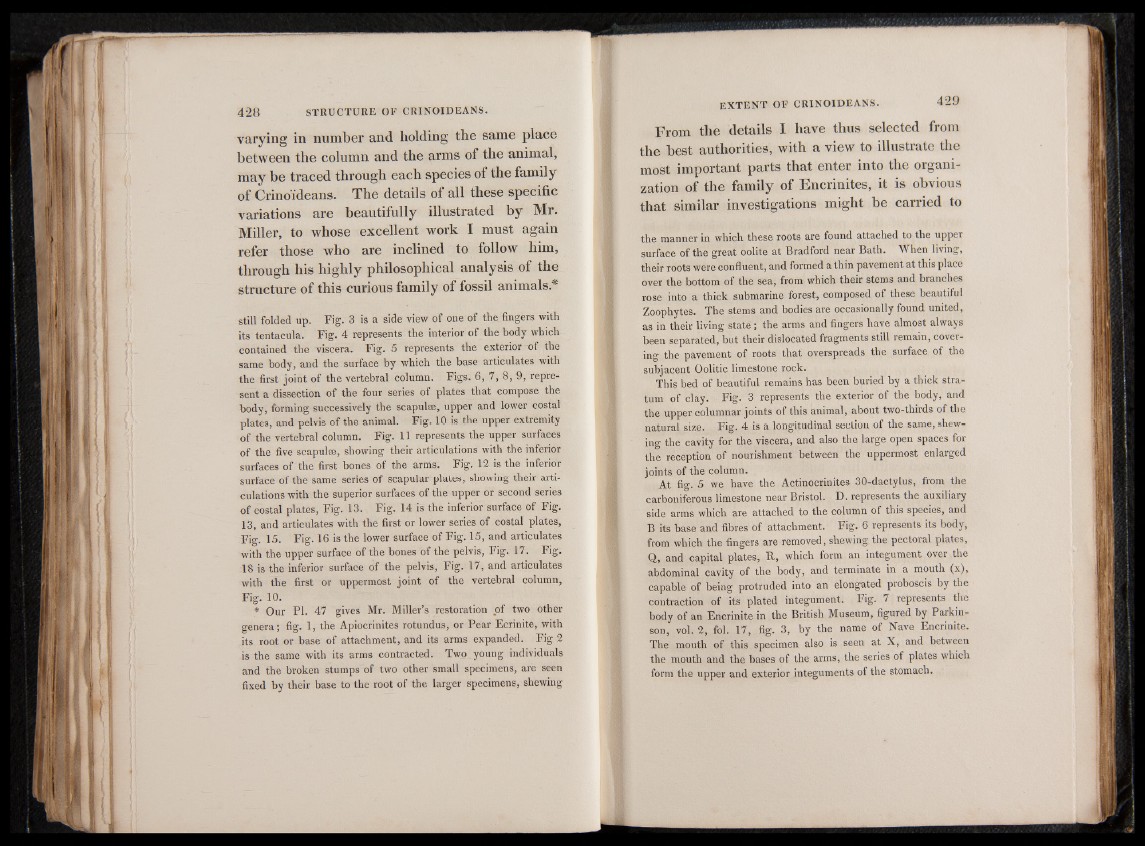
varying in number and holding the same place
between the column and the arms of the animal,
may be traced through each species of the family
of Crinoideans. The details of all these specific
variations are beautifully illustrated by Mr.
Miller, to whose excellent work I must again
refer those who are inclined to follow him,
through his highly philosophical analysis of the
structure of this curious family of fossil animals.*
still folded up. Fig. 3 is a side view of one of the fingers with
its tentacula. Fig. 4 represents the interior of the body which
contained the viscera. Fig. 5 represents the exterior of the
same body, and the surface by which the base articulates with
the first joint of the vertebral column. Figs. 6, 7, 8, 9, represent
a dissection of the four series of plates that compose the
body, forming successively the scapulae, upper and lower costal
plates, and pelvis of the animal. Fig. 10 is the upper extremity
of the vertebral column. Fig. 11 represents the upper surfaces
of the five scapulae, showing their articulations with the inferior
surfaces of the first bones of the arms. Fig. 12 is the inferior
surface of the same series of scapular plates, showing their articulations
with the superior surfaces of the upper or second series
of costal plates, Fig. 13. Fig. 14 is the inferior surface of Fig.
13, and articulates with the first or lower series of costal plates,
Fig. 15. Fig. 16 is the lower surface of Fig. 15, and articulates
with the upper surface of the bones of the pelvis, Fig. 17. Fig.
18 is the inferior surface of the pelvis, Fig. 17, and articulates
with the first or uppermost joint of the vertebral column,
Fig. 10.
* Our PI. 47 gives Mr. Miller’s restoration of two other
genera; fig. 1, the Apiocrinites rotundus, or Pear Ecrinite, with
its root or base of attachment, and its arms expanded. Fig 2
is the same with its arms contracted. Two young individuals
and the broken stumps of two other small specimens, are seen
fixed by their base to the root of the larger specimens, shewing
EXTENT OF CRINOIDEANS. 429
From the details I have thus selected from
the best authorities, with a view to illustrate the
most important parts that enter into the organization
of the family of Encrinites, it is obvious
that similar investigations might be carried to
the manner in which these roots are found attached to the upper
surface of the great oolite at Bradford near Bath. When living,
their roots were confluent, and formed a thin pavement at this place
over the bottom of the sea, from which their stems and branches
rose into a thick submarine forest, composed of these beautiful
Zoophytes. The stems and bodies are occasionally found united,
as in their living state; the arms and fingers have almost always
been separated, but their dislocated fragments still remain, covering
the pavement of roots that overspreads the surface of the
subjacent Oolitic limestone rock.
This bed of beautiful remains has been buried by a thick stratum
of clay. Fig. 3 represents the exterior of the body, and
the upper columnar joints of this animal, about two-thirds of the
natural size. Fig. 4 is a longitudinal section of the same, shewing
the cavity for the viscera, and also the large open spaces for
the reception of nourishment between the uppermost enlarged
joints of the column.
At fig. 5 we have the Actinocrinites 30-dactylus, from the
carboniferous limestone near Bristol. D. represents the auxiliary
side arms which are attached to the column of this species, and
B its base and fibres of attachment. Fig. 6 represents its body,
from which the fingers are removed, shewing the pectoral plates,
Q, and capital plates, R, which form an integument over the
abdominal cavity of the body, and terminate in a mouth (x),
capable of being protruded into an elongated proboscis by the
contraction of its plated integument. Fig. 7 represents the
body of an Encrinite in the British Museum, figured by Parkinson,
vol. 2, fol. 17, fig. 3, by the name of Nave Encrinite.
The mouth of this specimen also is seen at X, and between
the mouth and the bases of the arms, the series of plates which
form the upper and exterior integuments of the stomach.